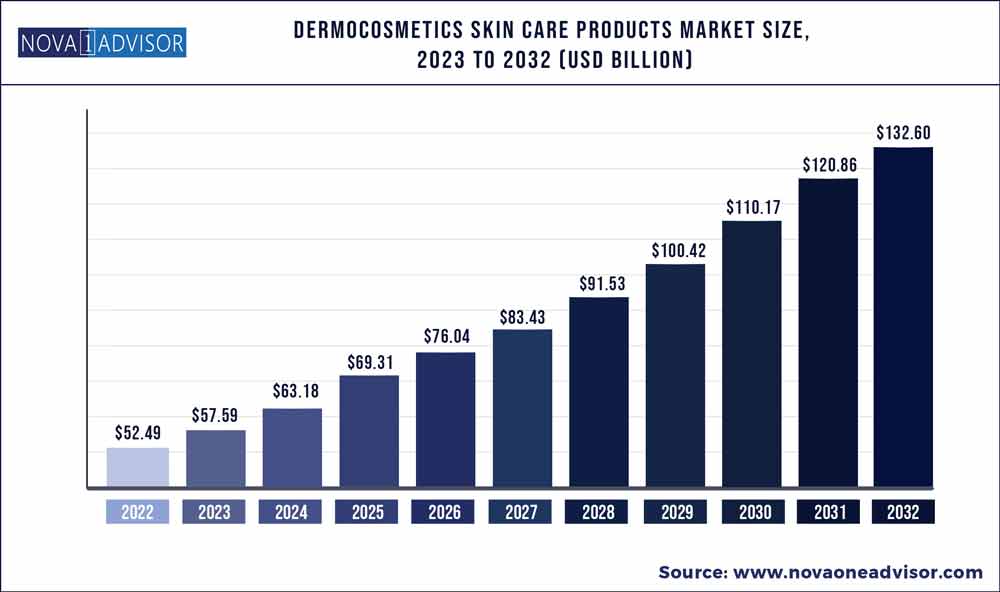The global dermocosmetics skin care products market size was exhibited at USD 52.49 billion in 2022 and is projected to hit around USD 132.60 billion by 2032, growing at a CAGR of 9.71% during the forecast period 2023 to 2032.

Key Pointers:
Dermocosmetics Skin Care Products Market Report Scope
|
Report Coverage |
Details |
|
Market Size in 2023 |
USD 57.59 Billion |
|
Market Size by 2032 |
USD 132.60 Billion |
|
Growth Rate From 2023 to 2032 |
CAGR of 9.71% |
|
Base Year |
2022 |
|
Forecast Period |
2023 to 2032 |
|
Segments Covered |
By Product and By Distribution Channel |
|
Market Analysis (Terms Used) |
Value (US$ Million/Billion) or (Volume/Units) |
|
Regional Scope |
North America; Europe; Asia Pacific; Central and South America; the Middle East and Africa |
|
Key Companies Profiled |
Procter & Gamble, L’Oréal Groupe, Unilever, Johnson & Johnson Services, Inc., Shiseido Co., Limited, Amorepacific, Beiersdorf, Kanebo Cosmetics Inc., Avon Products, Inc., Lotus Herbals Pvt. Ltd., VLCC Health Care Limited, Himalaya Global Holdings Ltd. and Others. |
Rising demand for personalized skin and scalp & hair care products and significant investments by several major cosmetics and pharmaceutical companies to develop new and improve existing skin care solutions are some of the factors driving the growth of the industry.Furthermore, the rising importance of the skincare regime and significant product innovations in the formulation and formats of dermocosmetics products, such as skin brightening, anti-aging, and other products, are further expected to contribute to the industry growth.
The COVID-19 pandemic has negatively impacted the global industry due to the disruption in the supply chain, manufacturing, and government restrictions imposed on retail stores across the globe. Moreover, major industry players experienced a decline in sales revenue during the COVID-19 pandemic, which further impacted the industry. For instance, L'Oréal Groupe reported a net sales decreaseof around 7.0% in fiscal 2020. However, the global cosmetics market is projected to recover in the future and witness strong growth due to resumed activities, sales, trade, and manufacturing across the globe.
Dermocosmetic products are manufactured using sophisticated formulations that are designed to multi-task with a more extensive approach to treat the root cause of a skin problem. For instance, Ducray, a dermocosmetics skincare brand, sells products formulated with Rhealba oats cultivated organically in the South of France and offers unique soothing cleansing, moisturizing, anti-aging, anti-acne, and hyper-pigmentation formulas. Such brands with unique formulations are likely to drive industry growth in the future. According to the American Academy of Dermatology Association, acne is the most common skin problem in the U.S., affecting approximately 50 million people each year.
UV rays, free radicals, pollution, stress, and eating disorders increase the breakdown of skin collagen and elastin, driving the demand for dermocosmetics products, especially among the working population. In addition, increasing concerns about skin and hair health have led to significant demand for well-tolerated, safer products with proven efficacy. However, the side effects of regular usage of cosmetic products due to the presence of harmful chemicals are projected to restrain growth during the forecast period. Personalized products have been gaining traction among consumers in the U.S.
With the increasing consumer inclination toward natural beauty products, the demand for creams, serums, and moisturizers infused with natural ingredients is expected to witness significant growth over the forecast period. Moreover, increasing investments in the research & development of products, coupled with the rising trend of natural ingredient-based skincare products, have encouraged manufacturers to launch new products. For instance, in January 2021, Kanebo Cosmetics Inc. launched the Scrubbing Mud Wash face wash and the Instant Off Oil face cleanser under its own Kanebo-labeled skincare category. The Scrubbing Mud Wash contains two cleansing ingredients-Moroccan lava clay and disintegrating scrub granules-which absorb excess sebum and scrub away dead skin cells.
The Instant Off Oil cleanser contains feathery light oil, rosehip oil, and olive oil. The growing awareness regarding skincare is further acting as a growth-drivingfactor. In addition, rising beauty awareness among men and monetary autonomy among women are other substantial factors contributing to the cosmetics products demand. In addition, appealing packaging of products, innovative branding activities, and promotional events increase product demand. Also, gift packages with various products targeting overall skin care are very popular among millennials, who constitute a major end-user segment. Moreover, marketing strategies targeting men and kids are gaining momentum in this industry.
Some of the prominent players in the Dermocosmetics Skin Care Products Market include:
Segments Covered in the Report
This report forecasts revenue growth at global, regional, and country levels and provides an analysis of the latest industry trends in each of the sub-segments from 2018 to 2032. For this study, Nova one advisor, Inc. has segmented the global Dermocosmetics Skin Care Products market.
By Product
By Distribution Channel
By Region